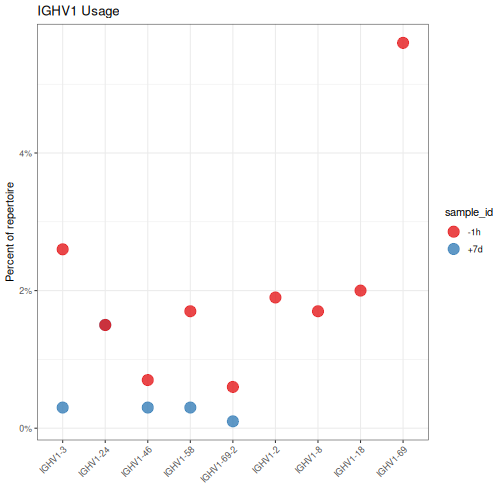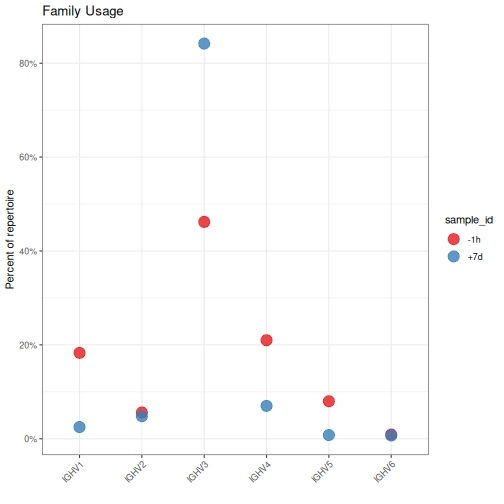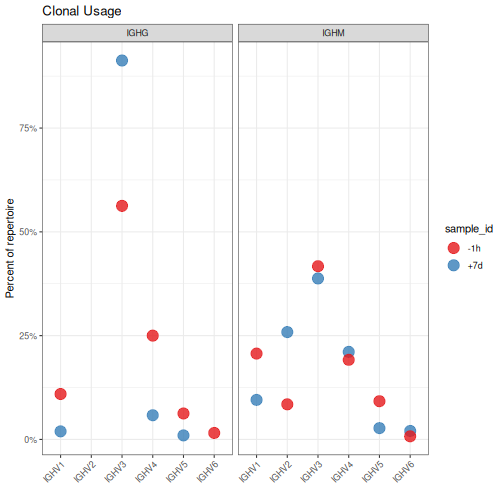Gene usage analysis¶
The ‘alakazam’ package provides basic gene usage quantification by either sequence count or clonal grouping; with or without consideration of duplicate reads/mRNA. Additionally, a set of accessory functions for sorting and parsing V(D)J gene names are also provided.
Example data¶
A small example AIRR database, ExampleDb, is included in the alakazam package. For details
about the AIRR format, visit the AIRR Community documentation site.
Gene usage analysis requires only the following columns:
v_calld_callj_call
However, the optional clonal clustering (clone_id) and duplicate count (duplicate_count)
columns may be used to quantify usage by different abundance criteria.
# Load required packages
library(alakazam)
library(dplyr)
library(scales)
# Subset example data
data(ExampleDb)
Tabulate V(D)J allele, gene or family usage by sample¶
The relative abundance of V(D)J alleles, genes or families within groups can be obtained
with the function countGenes. To analyze differences in the V gene usage across
different samples we will set gene="v_call" (the column containing gene data) and
groups="sample_id" (the columns containing grouping variables). To quantify abundance at
the gene level we set mode="gene":
# Quantify usage at the gene level
gene <- countGenes(ExampleDb, gene="v_call", groups="sample_id", mode="gene")
head(gene, n=4)
## # A tibble: 4 × 4
## # Groups: sample_id [2]
## sample_id gene seq_count seq_freq
## <chr> <chr> <int> <dbl>
## 1 +7d IGHV3-49 698 0.699
## 2 -1h IGHV3-9 83 0.083
## 3 -1h IGHV5-51 60 0.06
## 4 -1h IGHV3-30 58 0.058
In the resultant data.frame, the seq_count column is the number of raw sequences within each sample_id
group for the given gene. seq_freq is the frequency of each gene within the given sample_id.
Below we plot only the IGHV1 abundance by filtering on the gene column to only rows
containing IGHV1 family genes. We extract the family portion of the gene name using the
getFamily function. Also, we take advantage of the sortGenes function to convert the
gene column to a factor with gene name lexicographically ordered in the factor levels
(method="name") for axis ordering using the ggplot2 package. Alternatively, we could have
ordered the genes by genomic position by passing method="position" to sortGenes.
# Assign sorted levels and subset to IGHV1
ighv1 <- gene %>%
mutate(gene=factor(gene, levels=sortGenes(unique(gene), method="name"))) %>%
filter(getFamily(gene) == "IGHV1")
# Plot V gene usage in the IGHV1 family by sample
g1 <- ggplot(ighv1, aes(x=gene, y=seq_freq)) +
theme_bw() +
ggtitle("IGHV1 Usage") +
theme(axis.text.x=element_text(angle=45, hjust=1, vjust=1)) +
ylab("Percent of repertoire") +
xlab("") +
scale_y_continuous(labels=percent) +
scale_color_brewer(palette="Set1") +
geom_point(aes(color=sample_id), size=5, alpha=0.8)
plot(g1)

Alternatively, usage can be quantified at the allele (mode="allele") or
family level (mode="family"):
# Quantify V family usage by sample
family <- countGenes(ExampleDb, gene="v_call", groups="sample_id", mode="family")
# Plot V family usage by sample
g2 <- ggplot(family, aes(x=gene, y=seq_freq)) +
theme_bw() +
ggtitle("Family Usage") +
theme(axis.text.x=element_text(angle=45, hjust=1, vjust=1)) +
ylab("Percent of repertoire") +
xlab("") +
scale_y_continuous(labels=percent) +
scale_color_brewer(palette="Set1") +
geom_point(aes(color=sample_id), size=5, alpha=0.8)
plot(g2)

Tabulating gene abundance using additional groupings¶
The groups argument to countGenes can accept multiple grouping columns and
will calculate abundance within each unique combination. In the examples below,
groupings will be perform by unique sample and isotype pairs
(groups=c("sample_id", "c_call")). Furthermore, instead of quantifying abundance
by sequence count, we will quantify it by clone count (each clone will
be counted only once regardless of how many sequences the clone represents).
Clonal criteria are added by passing a value to the clone argument of countGenes
(clone="clone_id"). For each clonal group, only the most common allele/gene/family will
be considered for counting.
# Quantify V family clonal usage by sample and isotype
family <- countGenes(ExampleDb, gene="v_call", groups=c("sample_id", "c_call"),
clone="clone_id", mode="family")
head(family, n=4)
## # A tibble: 4 × 5
## # Groups: sample_id, c_call [3]
## sample_id c_call gene clone_count clone_freq
## <chr> <chr> <chr> <int> <dbl>
## 1 +7d IGHA IGHV5 1 0.0172
## 2 +7d IGHA IGHV6 1 0.0172
## 3 +7d IGHD IGHV6 1 0.0213
## 4 +7d IGHG IGHV5 1 0.00971
The output data.frame contains the additional grouping column (c_call) along with the
clone_count and clone_freq columns that represent the count of clones for each V family
and the frequencies within the given sample_id and c_call pair, respectively.
# Subset to IGHM and IGHG for plotting
family <- filter(family, c_call %in% c("IGHM", "IGHG"))
# Plot V family clonal usage by sample and isotype
g3 <- ggplot(family, aes(x=gene, y=clone_freq)) +
theme_bw() +
ggtitle("Clonal Usage") +
theme(axis.text.x=element_text(angle=45, hjust=1, vjust=1)) +
ylab("Percent of repertoire") +
xlab("") +
scale_y_continuous(labels=percent) +
scale_color_brewer(palette="Set1") +
geom_point(aes(color=sample_id), size=5, alpha=0.8) +
facet_grid(. ~ c_call)
plot(g3)

Instead of calculating abundance by sequence or clone count, abundance can be calculated
using copy numbers for the individual sequences. This is accomplished by passing
a copy number column to the copy argument (copy="duplicate_count"). Specifying both
clone and copy arguments is not meaningful and will result in the clone argument
being ignored.
# Calculate V family copy numbers by sample and isotype
family <- countGenes(ExampleDb, gene="v_call", groups=c("sample_id", "c_call"),
mode="family", copy="duplicate_count")
head(family, n=4)
## # A tibble: 4 × 7
## # Groups: sample_id, c_call [3]
## sample_id c_call gene seq_count copy_count seq_freq copy_freq
## <chr> <chr> <chr> <int> <dbl> <dbl> <dbl>
## 1 +7d IGHG IGHV3 516 1587 0.977 0.984
## 2 +7d IGHA IGHV3 240 1224 0.902 0.935
## 3 -1h IGHM IGHV3 237 250 0.421 0.386
## 4 -1h IGHM IGHV4 110 162 0.195 0.25
The output data.frame includes the seq_count and seq_freq columns as previously defined,
as well as the additional copy number columns copy_count and copy_freq reflected the summed
copy number (duplicate_count) for each sequence within the given gene, sample_id and c_call.
# Subset to IGHM and IGHG for plotting
family <- filter(family, c_call %in% c("IGHM", "IGHG"))
# Plot V family copy abundance by sample and isotype
g4 <- ggplot(family, aes(x=gene, y=copy_freq)) +
theme_bw() +
ggtitle("Copy Number") +
theme(axis.text.x=element_text(angle=45, hjust=1, vjust=1)) +
ylab("Percent of repertoire") +
xlab("") +
scale_y_continuous(labels=percent) +
scale_color_brewer(palette="Set1") +
geom_point(aes(color=sample_id), size=5, alpha=0.8) +
facet_grid(. ~ c_call)
plot(g4)
